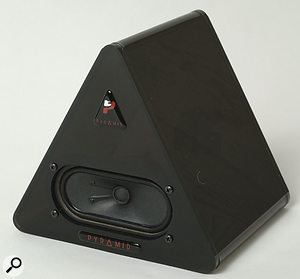Having read your review of the Triple P Pyramid monitors [SOS March 2004], I can understand the benefit of having lower-quality, or, at least, 'limited-range' monitors alongside studio-quality, full-range monitors so that you can hear what your mixes will sound like on small domestic 'hi-fi' systems. What I don't understand is what advantage there is in buying these monitors for £250, when a cheap pair of hi-fi speakers can cost as little as £30. Surely that would give a similar sound for a cheaper price?
SOS Forum Post
 The Triple P Pyramid monitors are designed to reveal problematic areas in the mix.Technical Editor Hugh Robjohns replies: I'm afraid it's not quite that simple. The Pyramid monitors, like the Auratone 5C and Yamaha NS10 monitors they take their lead from, aren't just 'limited-range' speakers. They have a very specific set of characteristics which are fundamental to their usefulness.
The Triple P Pyramid monitors are designed to reveal problematic areas in the mix.Technical Editor Hugh Robjohns replies: I'm afraid it's not quite that simple. The Pyramid monitors, like the Auratone 5C and Yamaha NS10 monitors they take their lead from, aren't just 'limited-range' speakers. They have a very specific set of characteristics which are fundamental to their usefulness.
For a start, they are all infinite baffle designs — meaning that the speaker cabinet is a sealed box — whereas most cheap hi-fi speakers use ported (or reflex) cabinets.
Porting is used to elevate the low-frequency response at the expense of mid-range clarity and transient response (often referred to as 'overhang'). So if you want to find a cheap substitute for these classic studio references, you have to look for a speaker that is a sealed-box design.
Next, the frequency response has a distinctive inverted 'V' shape, peaking in the mid-range and falling away gently above and below. This presents the most critical mid-range region in the best light and reduces the distraction caused by other, less critical, parts of the spectrum. Most cheap domestic speakers have an overly bright high end (to make them sound exciting), with a slightly reduced mid-range (to make them sound more pleasant and larger than they really are), and a lumpy, resonant bass end. The other thing to mention is that many cheap hi-fi speakers might not be able to cope with the often continuous high levels required in a professional mixing situation.
Trying to recreate the way these kind of monitors sound using EQ simply won't work either — the issue is far more complex than that, and is as much about time-domain response as frequency response. One of the key attributes of speakers like the Auratones and NS10s is that they have remarkably tidy impulse responses. If you input a sound with a fast transient — a kick drum, say — the sound starts very quickly and stops almost as quickly. Many reflex speakers tend to resonate or 'ring' for a significant period after the input signal has stopped, and that inherent ringing tends to mask subtle low-level detail, as well as giving a false impression of level, dynamics and even spectral balance. These aspects are absolutely critical when judging the right balance between instruments, especially at the bass end.
I agree that paying £250 for what are clearly very simple speakers that don't even sound particularly pleasant seems a foolish enterprise. However, these things are designed to serve as an accurate and reliable mixing tool, and a lot of engineers have found Auratones and NS10s indispensable in helping them to craft the mixes that keep them in employment. The Pyramids follow in the same genre and should serve as well in the future. That said, high-end monitoring has improved considerably in the last twenty years, so the role of monitors like the Auratones, NS10s and now the Pyramids is arguably not nearly as crucial now as it was then.
